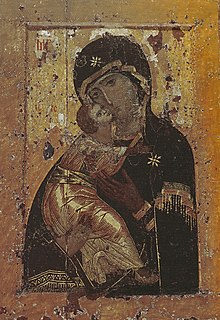| Virgin of Vladimir | |
|---|---|
| Russian: Владимирская икона Божией Матери: Our Lady of Vladimir | |
 | |
| Artist | Unknown, Luke the Evangelist according to Sacred Tradition |
| Year | 33(?)-1131 |
| Medium | Tempera |
| Subject | Virgin Mary |
| Dimensions | 104 cm × 69 cm (41 in × 27 in) |
| Location | Tretyakov Gallery, Moscow |

The Virgin of Vladimir, also known as Vladimir Mother of God, Our Lady of Vladimir[1] (Russian: Владимирская икона Божией Матери[a]), is a 12th-century Byzantine icon depicting the Virgin and Child and an early example of the Eleusa iconographic type. It is one of the most culturally significant and celebrated pieces of art in Russian history. Many consider it a national palladium with several miracles of historical importance to Russia being attributed to the icon. Following its near destruction in the thirteenth century, the work has been restored at least five times.
The icon was painted by an unknown artist most likely in Constantinople, or painted by Luke the Evangelist and sent through Anatolia to Thrace. It was sent to Kiev as a gift before being transferred to the Assumption Cathedral in Vladimir. It is traditionally said that the icon did not leave Vladimir until 1395, when it was brought to Moscow to protect the city from an invasion by Timur, although the historical accuracy of this claim is uncertain. By at least the sixteenth century, it was in the Dormition Cathedral in Moscow where it remained until it was moved to the State Tretyakov Gallery after the Russian Revolution.
It was subject to an ownership dispute in the 1990s between the gallery and Moscow Patriarchate, which ended with its relocation to the Church of St. Nicholas in Tolmachi. An arrangement was made to operate the church with dual status as a house church and part of the museum. The icon remains there today, and is only accessible via an underground passage from the gallery to the church, where liturgies are still held.
- ^ Yegorov (2018), online.
Cite error: There are <ref group=lower-alpha> tags or {{efn}} templates on this page, but the references will not show without a {{reflist|group=lower-alpha}} template or {{notelist}} template (see the help page).